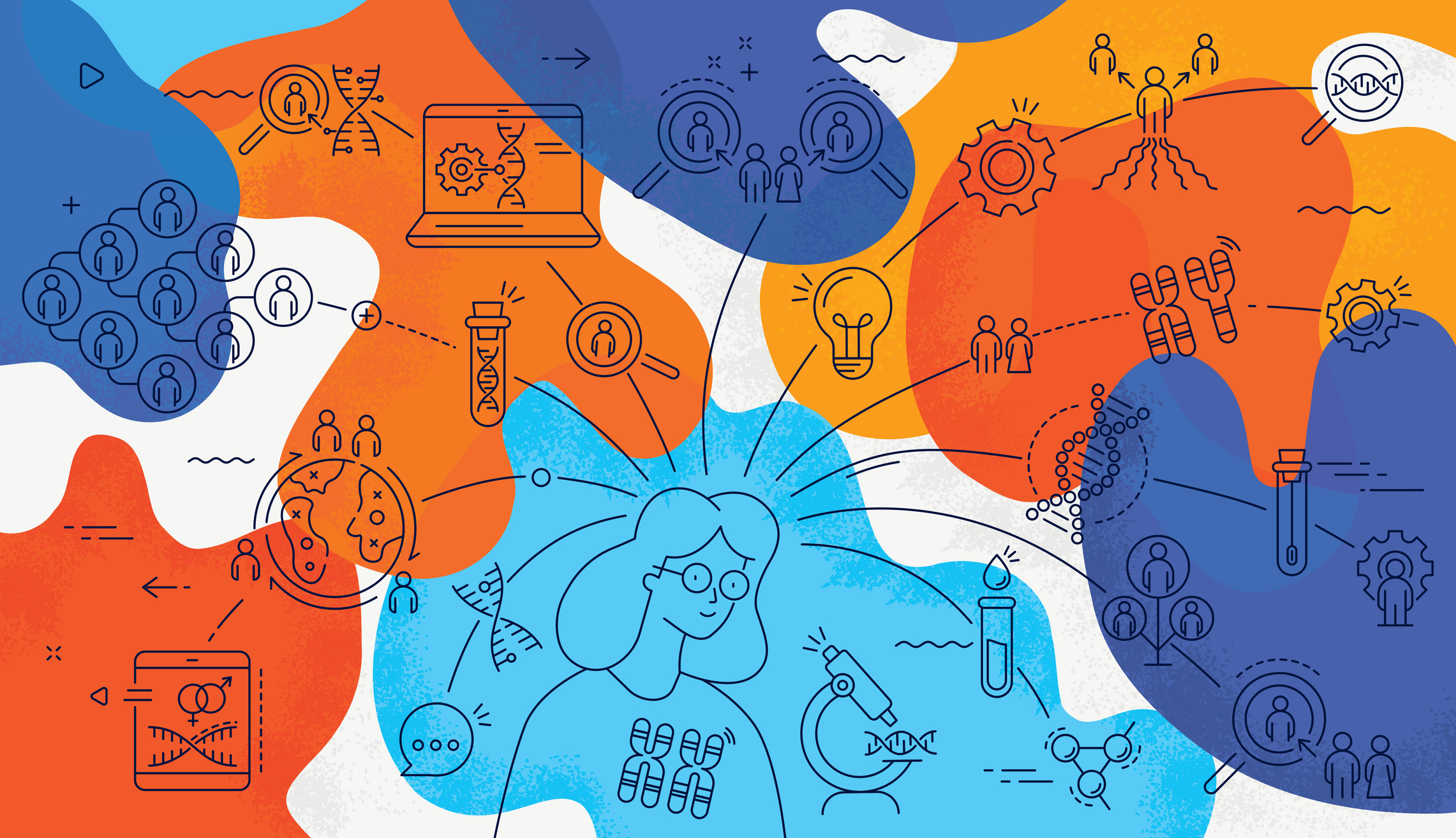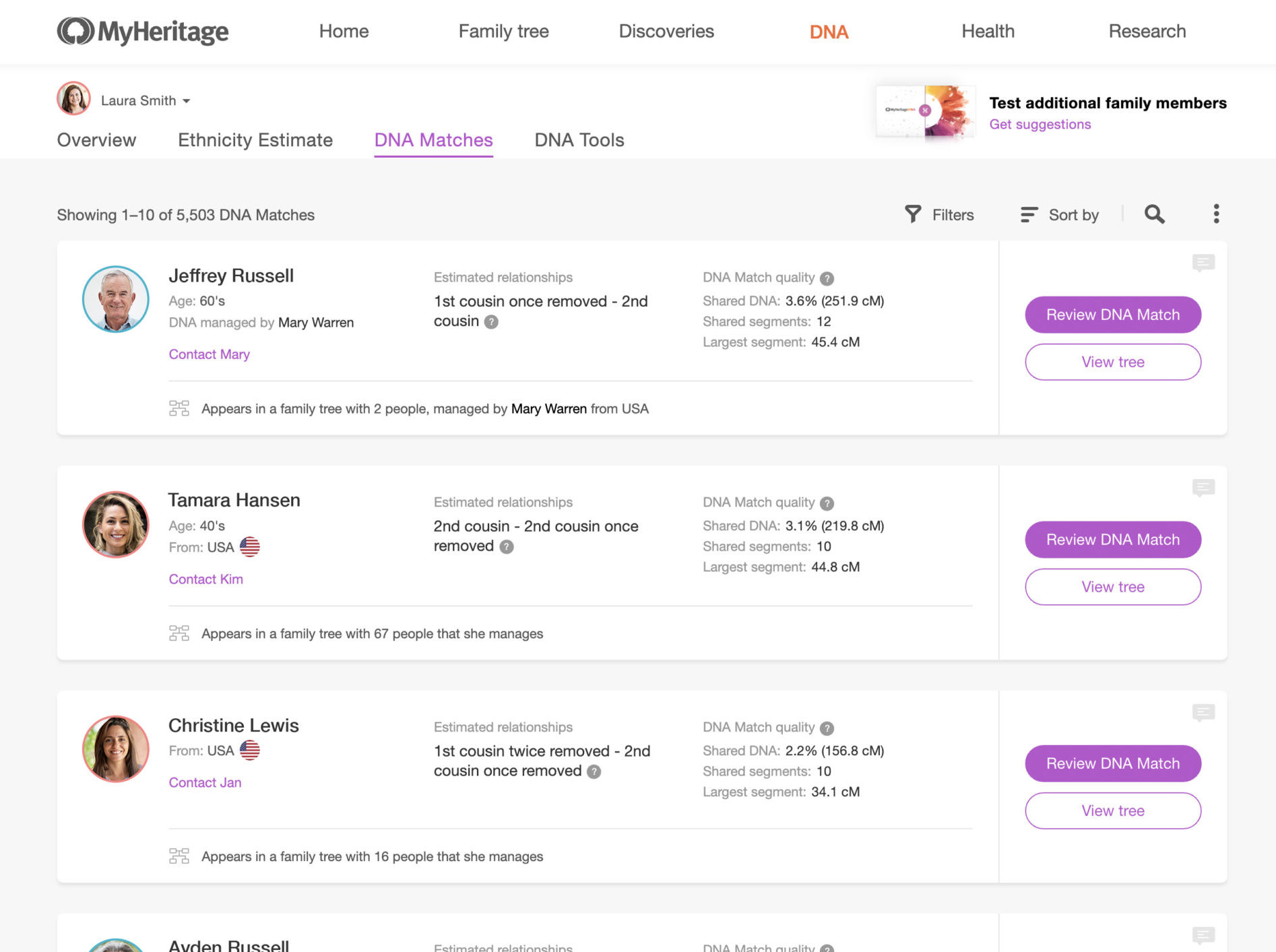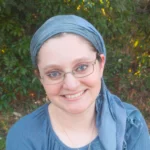
Genetisk släktforskning är en relativt ny riktning inom familjehistorisk forskning, och många traditionella släktforskare kan tycka att konceptet med att arbeta med något så banbrytande och vetenskapligt som DNA är skrämmande.
Men du behöver inte ha ett huvud för vetenskap eller avancerad matematik för att dra nytta av genetisk släktforskning. Du behöver inte ens ha en djup förståelse för hur DNA fungerar. Allt du behöver är en förståelse på mellanstadietivå av genetiskt arv, några bra verktyg för att hjälpa dig att sortera igenom information, och samma beslutsamhet och noggrannhet som tjänar dig med resten av din släktforskning.
I den här artikeln kommer vi att utforska vad genetisk släktforskning är, hur det kan hjälpa dig med din släktforskning och några av de bästa metoderna för att få ut det mesta av DNA för släktforskning.
Vad är genetisk släktforskning?
Genetisk släktforskning är att använda DNA-data för att förbättra genealogisk forskning och eventuellt ”bryta igenom tegelväggar”, lösa familjens mysterier och utöka ditt släktträd.
Minnen från den levande äldste i din familj och dokument kan ta dig långt men det är begränsat. Detta gäller särskilt om du inte har många äldre i din familj som kan dela minnen med dig, eller om dina förfäder kom från en plats där dokumentationen var knapp. Om du stöter på återvändsgränder kan genetisk släktforskning hjälpa dig att ta upp tråden där de andra kanalerna slutade.
Genetisk släktforskning bygger på DNA-testning och matchning. Det är dock viktigt att betona att DNA-data inte kan stå ensamma för släktforskningssyfte. Slutsatser från DNA-testning om din familjehistoria måste stödjas av traditionella släktforskningskällor.
Hur kan DNA-testning hjälpa mig med släktforskning?
Det finns några sätt som DNA-testning kan hjälpa dig att expandera ditt träd och lösa familjens mysterier.
Att hitta förlorade eller okända släktingar
Om du har nära släktingar som saknas i ditt släktträd, till exempel familjemedlemmar som var främmande, tappade kontakten med varandra eller som adopterades av en annan familj, kan DNA -testning hjälpa dig att hitta dem direkt genom din DNA -matchningslista. Personen du letar efter kan ha testat DNA själv, eller ha en nära släkting som gjorde och kan sätta dig i kontakt med dem.
If you have close relatives missing in your family tree, such as family members who were estranged, lost touch with each other, or who were adopted by another family, DNA testing can help you find them directly through your DNA match list. The person you’re looking for may have tested DNA themselves, or have a close relative who did and can put you in touch with them.

Connecting with other genealogists in your extended family
You may have a distant cousin somewhere out there who has done their own genealogy research. This cousin may be able to provide information about common ancestors that you wouldn’t find anywhere else. DNA matching can help you discover and connect with these relatives. MyHeritage allows you to contact your DNA Matches through a secure messaging system.
Confirming relationships
You might find a record of someone you think might be your ancestor, but can’t find evidence that proves their connection to you. Using DNA testing strategically, you may be able to verify your relationship to this ancestor by proving your relationships to confirmed living descendants.
Confirming origins, or identifying regions to focus on
Most DNA testing services also provide an ethnicity report, such as MyHeritage’s Ethnicity Estimate. While this information is not precise enough to rely upon for genealogical research purposes, it can help confirm what you already know about your ancestors’ origins.
It can also help you zero in on the resources that may lead you to make genealogical discoveries. For example, let’s say you know that your mother’s side was from England but don’t know where your father was from. If your Ethnicity Estimate reveals that you have Scandinavian roots, this suggests that your father may have been from Scandinavia. You may want to focus on records from this region when researching his side of the family.
MyHeritage’s Genetic Groups are particularly helpful when trying to narrow down regions to focus on. The results they provide can be extremely precise, sometimes even identifying a specific city or town your ancestors came from.

Best practices for genetic genealogy
Test as many people as you can
Genetic genealogy relies on DNA matches. The more known relatives you test, the more information you’ll have to work with when reviewing and analyzing your unknown matches.
Because of the way DNA inheritance works, you receive less and less DNA from each generation back. So if for example you’re researching a great-great-grandmother, you’ve inherited only around 6% of her DNA. You will greatly increase your chances of learning more about this ancestor if you increase your “coverage” of her DNA, and you can do that by testing additional descendants of hers, ideally from different branches of the family, so you can discover and contact additional DNA matches that inherited different sections of her DNA than you did.
Test strategically
All that said, swabbing the cheeks of every cousin who stands still long enough isn’t a very practical strategy! DNA kits are not a dime a dozen, and getting consent from cautious relatives may be tricky. (Perhaps telling them about MyHeritage’s unwavering commitment to the privacy of our customers’ data will help reassure them.) So rather than test willy-nilly, you should set out a DNA testing strategy that focuses your testing efforts on the family members whose information will be most valuable to you.
That may sound like a simple concept, but the ideal strategy could be wildly different depending on your goals. Tailor your testing plan to the specific information you are trying to find, whether it’s identifying an unknown direct ancestor, overcoming a migration-related brick wall, or confirming a suspected relationship that hasn’t been proven beyond a doubt by the documentation you’ve found.
Choose the right DNA test
There are several types of genealogy DNA test on the market. The most common are:
- Autosomal: Analyzes the autosomes, that is, the 22 non-sex chromosomes
- Y-DNA: Analyzes the Y chromosome, only present in males and inherited from the paternal line
- Mitochondrial or mtDNA: Analyzes mitochondrial DNA inherited from the maternal line
The MyHeritage DNA test is an autosomal test. We believe this type of test holds the most value for genealogists as it provides the widest coverage of matches on both the maternal and paternal sides, and in many cases can do the work of the Y-DNA or mtDNA test just as well. (Click here to read how to research your maternal and paternal lines using the MyHeritage DNA test.) However, if you are specifically researching a maternal or paternal ancestor, there may be value in taking a Y-DNA or mtDNA test instead.
Take full advantage of DNA tools
MyHeritage provides a number of tools that can help you make sense of your DNA matches and achieve important insights.
- Shared DNA Matches: When reviewing a given DNA match, you will find a section called “Shared DNA Matches” that lists matches you have in common with this person. Perusing this list may give you clues about who your common ancestors are.
- Advanced sorting and filtering options: On MyHeritage, you can sort and filter your DNA Matches according to a number of criteria, helping you focus on the matches that will be of greatest value to you.
- Family tree information: If a DNA Match is associated with a profile on a family tree, you’ll be able to view the public information on that tree (generally the information on relatives who are deceased). This can help you identify common relatives and ancestors.
- Comments: MyHeritage allows you to add comments to DNA Match cards on your list of matches, which can help you keep track of the matches you’ve already reviewed and the information you gleaned from them.
- One-to-many Chromosome Browser: The chromosome browser allows you to compare your DNA to that of multiple DNA matches and identify triangulated segments (segments that all of you share). This can provide further clues about your relationship to that match and your common ancestors.
- AutoClusters: AutoClusters is like “Shared DNA Matches” on steroids. It organizes your DNA matches into groups of individuals who all match each other and therefore likely have a common ancestor. This can save you a lot of time figuring out who is related to whom.
- Theory of Family Relativity™: This feature basically does all the work for you — it analyzes all the data at our disposal, including family tree data and historical record data, to bring you plausible theories about exactly how a given DNA match is related to you.
Ready to give it a try? Click here to order your MyHeritage DNA test.
Some webinars on genetic genealogy that you may find helpful:
- Why Take a DNA Test for Genealogy Research? by Mike Mansfield (webinar)
- How to Find Unknown Family with MyHeritage DNA by Christina Sagersten
- Science for the Non-Scientist: How Does MyHeritage Produce Their DNA Results? by Diahan Southard (webinar)
Click here to view more Knowledge Base resources on genetic genealogy.



